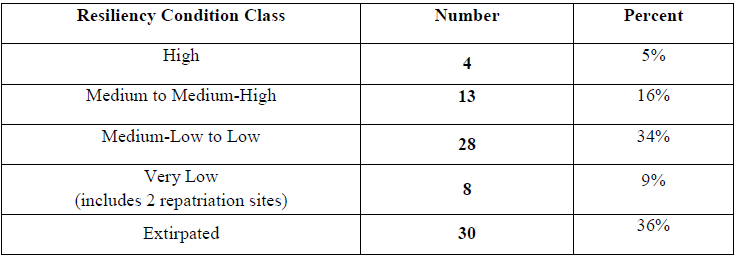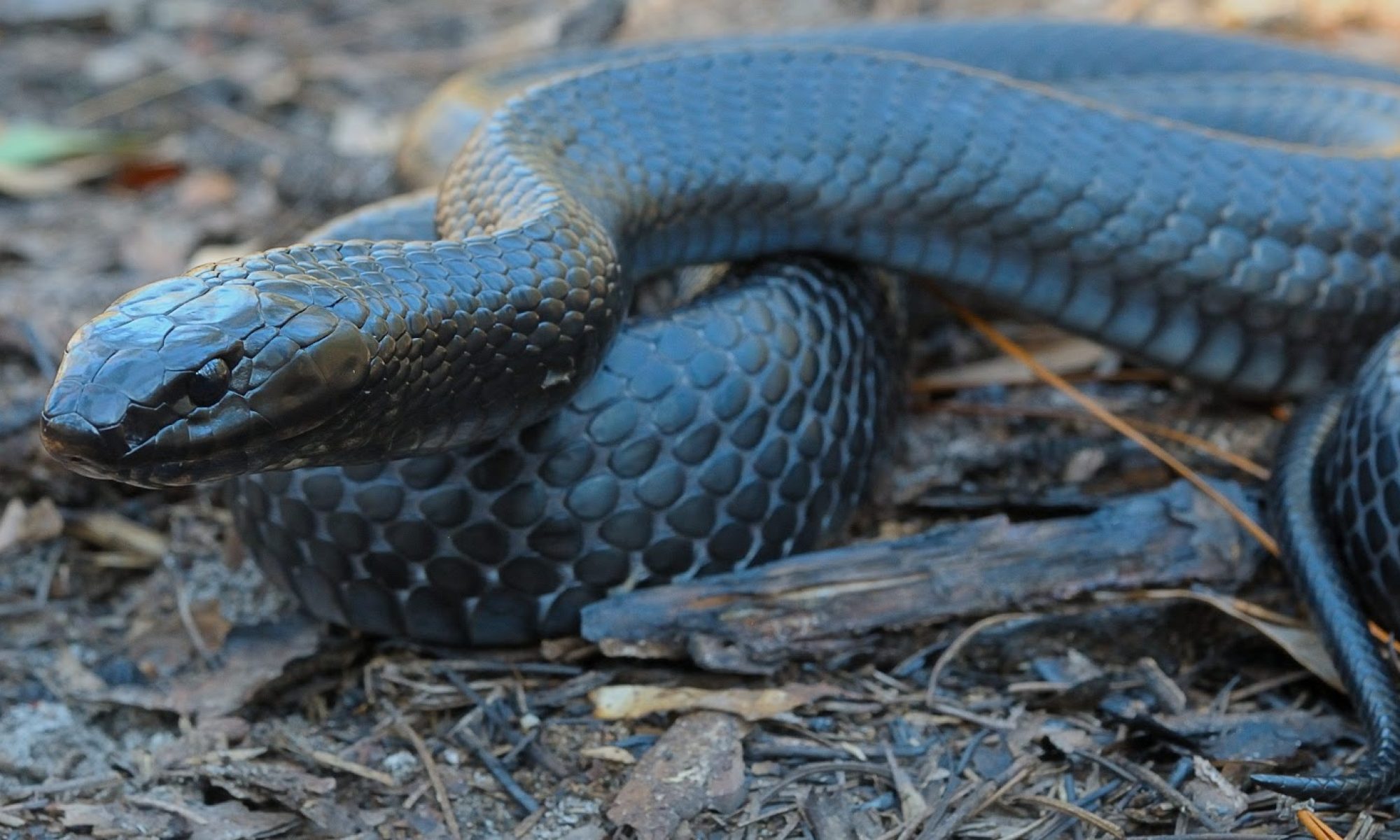We use potential populations (hereafter populations) as described above as our analytical unit and describe population and habitat factors that influence the resiliency of each population. While there are multiple population and habitat factors that can affect resiliency, we focused on the most significant factors that influence eastern indigo snake populations and for which we have sufficient data. To summarize the overall current conditions of eastern indigo snake populations, we sorted them into five categories (high, medium, low, very low and extirpated) based on the population factors and habitat elements described below and summarized in Table 2. Populations presumed to be extirpated are included to portray the difference between the historical and current condition of the species. The current condition category is an estimate based on the analysis of two population factors (population extent and population connectivity) and six habitat factors reflecting habitat quantity and quality (habitat amount, habitat type, habitat fragmentation, shelter site availability, tertiary road density and percent urbanized). Population and habitat factors assessed in this report are summarized below. Additional detail and methodology for estimating each population and habitat factor are provided in Appendix B, and results for each population are summarized in Table B3 (in Appendix B).
5.2.1 Population Factors that Influence Resiliency
Demographic data provide a basis for understanding the ecology of a species. We have gained important information on the species’ demography from multiple radiotelemetry studies (Speake et al. 1978, Moler 1985b, Smith 1987, Breininger et al. 2004, Dodd and Barichivich 2007, Hyslop 2007, Hyslop et al. 2009a, Jackson 2013, Metcalf 2017, Bauder et al. 2018), mark-recapture efforts (Layne and Steiner 1996; Stevenson et al. 2003, Stevenson et al. 2009, Hyslop et al. 2012, Jenkins 2017) and visual encounter surveys and road-cruising (Godley and Moler 2013), however little is known regarding demographic parameters and population trends. This is primarily because of the difficulties in obtaining adequate sample sizes (Hyslop et al. 2012, p.146). Occupancy surveys are being implemented in portions of the snake’s range (Bauder et al. 2017, entire); however, data are still very limited for estimating population attributes, such as density, abundance and recruitment. Therefore, we limited our assessment of population factors affecting resiliency to total population extent using the population definition above and connectivity among those populations.
Population Extent estimates the maximum extent of an area potentially used by a population. Population extent was calculated using the 5-mi buffer rule described in section 5.1. Using maximum extent aims to capture the majority of the area potentially used by population but also over-estimates the actual area used because it includes both eastern indigo snake habitat and non-habitat areas. Although some species may expand their home range when habitat quality declines (Van Horne 1983, entire), studies on eastern indigo snakes found that home ranges in urban and fragmented landscapes were significantly smaller than those snakes in more natural landscapes (Breininger et al. 2011, entire, Bauder et al. 2018, p. 755). Although home ranges of eastern indigo snakes tracked in Georgia showed some degree of overlap (Hyslop et al. 2014, p.106), same-sex home range overlap was reported to be generally very low in Peninsular Florida (Bauder et al. 2016a). Therefore, we assume there is increased potential for more individuals to interact within larger population extents and therefore resiliency increases.
Population Connectivity- For the eastern indigo snake to persist as isolated populations within a previously more extensive and connected range, the degree of genetic exchange between populations is critical to reduce the risk of extinction from inbreeding and reduced capacity for evolutionary adaptation (Carlson et al. 2014, p. 523). A lack of periodic gene flow between populations can exacerbate impacts of various stressors and reduce the frequency of adaptive alleles. Dispersal of individual eastern indigo snakes over long distances (greater than 5 mi) is not well-known and considered rare; however, an adult male in Georgia was recaptured over 13.5 mi (22 km) linear distance from its original capture location (Stevenson and Hyslop 2010, entire).
Population connectivity (or genetic connectivity) is defined here as the ability for an individual snake from one population to periodically disperse to another population. Populations, as described above, are represented by two or more eastern indigo snake records that are within 5 mi of each other and are potentially demographically connected. Connectivity between populations requires suitable habitat, unfragmented by roads and, shorter and wider corridors than those needed for more vagile animals (Breininger et al. 2012, p. 366) to allow for long distance dispersal, resulting in the maintenance of gene flow across the range and long term persistence. The population connectivity distance for this assessment is represented by a 10-mile (16 km) buffer around eastern indigo snake records (5-mile buffer from record to delineate the population plus an additional 5-mile buffer to assess connectivity among populations). When 10-mile buffers overlapped, populations were considered connected if habitat was present and was not bisected by primary or secondary roads. See Appendix B, Figure B2 for illustration.
5.2.2 Habitat Factors that Influence Resiliency
Due to the difficulties of observing and capturing eastern indigo snakes, even where they are known to occur, the viability of populations is difficult to directly measure. However, research on eastern indigo snake populations has provided important information regarding the species’ response to habitat conditions. Therefore, we consider six habitat factors reflecting both habitat quantity and quality that influence the resilience of eastern indigo snake populations. These habitat factors are summarized below and additional detail is provided in Appendix B.
Habitat Quantity- A GIS model was generated for the eastern indigo snake (Appendix C) to assess the current range-wide status of habitat availability and quality. The model identified 39.6 million acres (16.0 million ha) of potential habitat within the known range of the species; however only 16% of this area is within the known extent of eastern indigo snake populations (Figure 22). The potential habitat within the current population extent of eastern indigo snakes (identified by buffering records by 5 mi as described in section 5.1) is estimated at 6.4 million ac (2.7 million ha). Habitat patches were categorized as primary, secondary and tertiary habitat. Primary habitat identifies the characteristic natural upland habitats preferred by eastern indigo snakes across most of its range. Secondary habitats include other natural habitats, including lowlands, often important for foraging. Tertiary habitats include human-altered landscapes (e.g. pasture, citrus orchards) that may also support critical resource needs. For a complete description of the model methodology refer to Appendix C. Because we know eastern indigo snakes have relatively large home ranges and conspecific overlap of eastern indigo snakes is generally low, it is assumed that habitat quantity requirements are relatively large. Therefore we assessed the total amount of habitat (primary + secondary + tertiary) for each population.
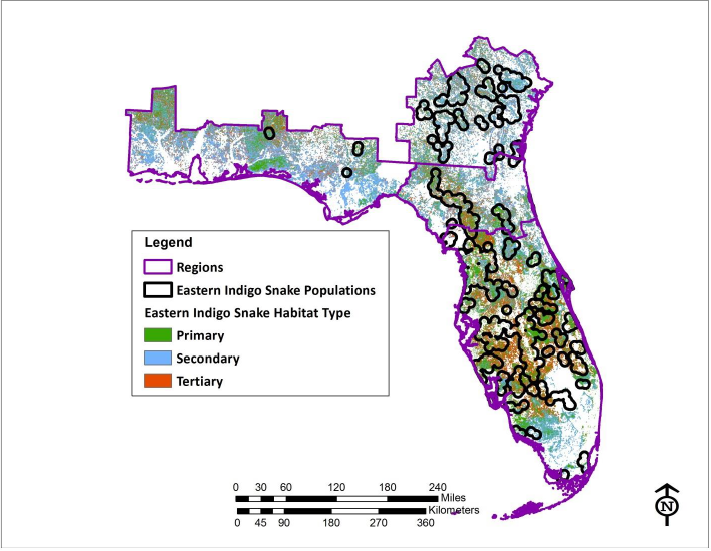
Habitat Quality describes the level of fragmentation, density of tertiary roads, percent of the population extent that is urbanized, presence of shelter (i.e. gopher tortoise presence) and percent of total habitat that is considered primary and secondary (habitat type).
Habitat Fragmentation (within population): Using the Eastern Indigo Snake Habitat Model (Appendix C), fragmentation was assessed by calculating the area of habitat patches of different sizes for each population. Habitat patches for this assessment could contain all three types of habitat (primary, secondary and tertiary). Breaks in habitat patches reflect significant breaks in habitat connectivity or non-habitat between patches and often were due to primary or secondary roads, major water bodies and other areas of non-habitat. It has been suggested that eastern indigo snake populations that occur on lands with multiple habitat patches of at least 2,500 ac (1,000 ha) (i.e. >5,000 ac) may have the best chance of long-term viability (Moler 1992). However, high urban edge to habitat area (e.g. habitat edges created by roads or human-altered habitats) has greater extinction risk (Breininger et al. 2004, 2011, and 2012, entire). A recent study suggested 2,500 ac is too small to support even a single pair of eastern indigo snakes and suggested about 12,000 – 22,000 ac (5,000 – 9,000 ha) of unfragmented habitat is needed to sustain eastern indigo populations in central Florida (Bauder 2018, p. 160). A modeling study by Sytsma et al. (2012, pp. 39–40) estimated a reserve size of 10,000 ac (4,047 ha) to be sufficiently large to support a small population of eastern indigo snakes. However, Hyslop et al. (2014, p.109) reported that the collective extent of eastern indigo snakes studied around Fort Stewart in Southeast Georgia, where the snakes are believed to travel the farthest distance, was about 20,000 to 35,000 ac (8,000 to 14,000 ha). We used these suggestions from the literature to develop rules to classify the degree of habitat fragmentation for populations as shown in Table 2.
Tertiary Road Density: Primary and secondary roads are prominent features of urbanized areas and can contribute to isolation and fragmentation of eastern indigo snake populations because they often avoid these type of roads (Bauder et al. 2018, p.751), but they may eventually cross these road types when habitat patch sizes decrease and urban edge to habitat area ratio increases (Breininger et al. 2004, 2011, and 2012, entire). However, eastern indigo snakes have been found to readily cross tertiary roads subjecting individual snakes to road mortality which can contribute to population declines (Rothermel 2017, p. 22, Godley and Moler 2013, entire) and therefore large tracts of undeveloped land with low densities of tertiary roads is needed (Bauder et al. 2018, p. 759). Tertiary roads are paved roads, often characteristic of more rural areas, and generally did not contribute to breaks in habitat patches in the habitat model. Therefore, the density of tertiary roads (miles per 50,265 ac) (USGS 2017) for each population was assessed separately from fragmentation and urbanized area as a measure of habitat quality for each population.
Urbanized Area: Urbanization destroys and fragments habitat and increases direct mortality due to increased human contact. While eastern indigo snakes have been observed entering urban and suburban areas (Breininger et al. 2004, p.15), eastern indigo snakes generally avoid urbanized areas (Bauder et al. 2018, p.754). Urbanized area is assumed to be correlated with the habitat factors above. For instance, habitat quantity and shelter site availability is assumed to decrease with increasing urban area, and habitat fragmentation and tertiary road density is assumed to increase with increased urban area. However, factors such as direct mortality from increased human and predator interaction would also increase with increasing urban area. Therefore as an additional measure of habitat quality, we assessed percent urbanized area for each population using the base model (2010) of the SLEUTH (Slope, Land use, Excluded area, Urban area, Transportation, Hillside area) model (Terando et al. 2014, p. 2).
Shelter Sites (gopher tortoise): Eastern indigo snakes require shelter for protection from cold and hot temperatures throughout their range. In the northern part of the range eastern indigo snakes have a strong dependency on gopher tortoises and their burrows for dens during the winter. It is suspected that the decline of eastern indigo snakes in the northern portion of its range, especially in the Panhandle, is related to declines in gopher tortoises (Enge et al. 2013, p.289). In the southern part of the range eastern indigo snake may use other forms of shelter in addition to gopher tortoise burrows, although presence of gopher tortoises and their burrows typically represent good quality habitat and are therefore assessed as a component of habitat quality. We used the results of the 2018 Gopher Tortoise Candidate Conservation Agreement (CCA) report (CCA 2018) to assess presence of gopher tortoise populations for each eastern indigo snake population.
Habitat Type: We assessed the percent of total habitat that is considered primary and secondary as a measure of habitat quality. Eastern indigo snakes require diversity in habitat types to support essential life functions of breeding, feeding, sheltering and nesting. They depend on (in northern portion of range) or prefer (southern portion of range) upland habitat types as their primary habitat. In the northern portion of the range they are highly dependent on sandhills with gopher tortoise burrows for shelter during winter months. In central and south Florida the dependence on gopher tortoises is lower and they are known to use a variety of habitats and shelters, however, snakes continue to exhibit a strong preference to upland habitats (Bauder et al. 2018 pp. 754-755). Secondary habitat is also natural, but is generally hardwood, lowland and wetland dominated habitat types and is often used for foraging (feeding). It is believed that a combination of both primary and secondary habitat provides the best matrix of habitat types to support viable eastern indigo snake populations. Tertiary habitat represents potential foraging habitat, but include anthropogenic habitat such as citrus orchards and agricultural fields. Eastern indigo snakes are known to use these habitats, but generally prefer natural primary and secondary habitat (Bauder et al. 2018, p. 754). Tertiary habitat often has altered ecology and increased vulnerability to stressors (e.g. roads, predators, disease, human interaction, etc.) making these habitats of lower quality.
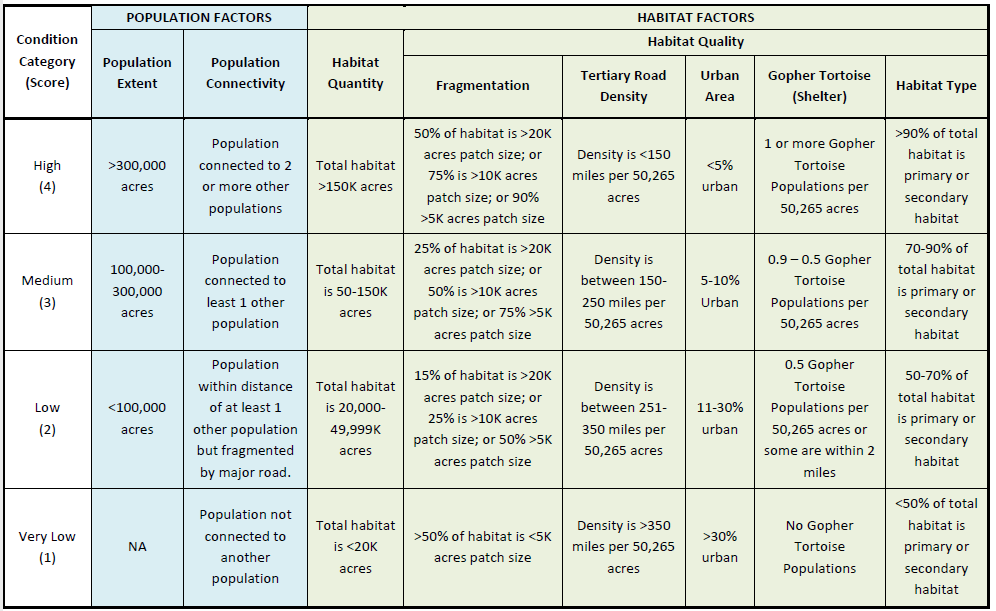
5.2.3 Overall Resiliency Calculations
First, eastern indigo snake populations were assigned a score (“high” to “very low” represented by the numerical values of 4 to 1, respectively) for each population and habitat factor as described in Table 2 above. The population factors (population extent and connectivity) were considered equally important when estimating the combined population score, which was simply an arithmetic average of the two factors. To estimate the combined habitat score, habitat factors were given a baseline weight of 1 and then we adjusted the weights depending on their importance to eastern indigo snakes as documented in the literature. For northern populations gopher tortoise presence was given a weight of 2 because of the snake’s apparent dependence on gopher tortoise burrows for winter shelter sites compared to southern populations which was given a weight of 1. Because eastern indigo snakes have large home ranges, habitat fragmentation may have significant negative impacts on long-term population viability. Therefore, habitat fragmentation was given a weight of 2 for both northern and southern populations. Additionally due to the impact of direct mortality from tertiary roads, this factor was weighted as 1.5 for both northern and southern populations. Percent urban is highly correlated with tertiary roads (Appendix B, Figure B3), but also represents additional negative factors such as direct mortality from increased human and predator interaction. Therefore percent urban was given a weight of 0.5, giving tertiary roads and percent urban a cumulative weight of 2. The remaining habitat factors, habitat quantity and type, were each given a baseline weight of 1. Table 3 summarizes the assigned weights for the habitat factors. A more detailed explanation for assigning weights to the habitat factors is provided in Appendix B.

Next, using the scores and weights described above, we calculated a total population factor score and total habitat factor score for each eastern indigo snake population, which resulted in a continuous numerical value ranging between 1 and 4, and we assigned a condition class of High, Medium, Low or Very Low as described in Table 4.

Finally, we summarized overall current resiliency condition classes for each eastern indigo snake population by combining the total population and habitat condition classes (e.g. Population Condition Class = Medium and Habitat Condition Class = High, Overall Current Condition Class = Medium-High; or Population Condition Class = Medium and Habitat Condition Class = Low, Overall Current Condition Class = Medium-Low; or Population Condition Class = High and Habitat Condition Class = Low, Overall Current Condition Class = Medium). The intermediate condition classes (medium-high and medium-low) provide some insight to populations that are near the thresholds of the high condition class (medium-high) or medium condition class (medium-low), but are considered medium and low in overall condition, respectively. See Table B3 (in Appendix B) for calculations for each eastern indigo snake population. Figure 23 depicts each population and its estimated overall current resiliency condition class (see Appendix B, Table B3 for naming conventions for each population).
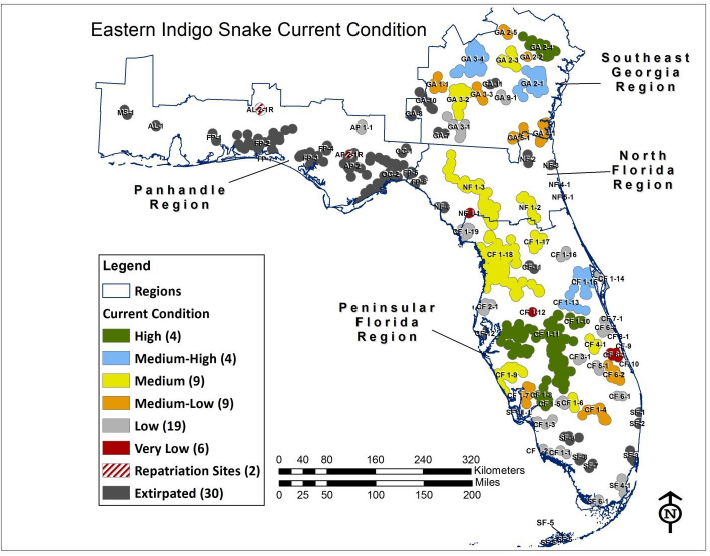
Current Condition Resiliency Summary:
Of the 83 populations assessed for current conditions, 36% are extirpated and 9% are in very low condition. Thirty-four percent (34%) are in low to medium-low condition, 16% are in medium to medium-high condition, and 5% are in high condition (Table 5).
The highly resilient populations are found in the central portion of the Peninsular Florida region (CF 1-11, CF 1-10 and CF 1-8) and the northern region of the Southeast Georgia region (GA 2-4) (Figure 23). Populations considered in medium condition are largely found in the North Florida region, the northern portion of the Peninsular Florida region and scattered smaller populations in Southeast Georgia and southern Peninsular Florida. The majority of the extirpated populations are in the western portion of the range in the Panhandle region and the western area of the Southeast Georgia region. Other extirpated populations occur along the eastern side of the North Florida region and in the southern extreme of Peninsular Florida. Low and Very Low resilience populations are found along the coasts and near extirpated populations.
